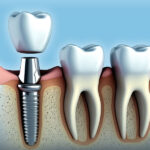A dental bridge is a fixed device that replaces one or more missing teeth to restore the full function of your teeth. An artificial tooth is attached to the natural tooth or a permanent dental implant to fill a gap in your smile.
The dentist in Cambridge places dental bridges made of the material that suits your needs and preferences. These teeth replacements may be made of metal, zirconia, porcelain or ceramic material, or even a metal base with a ceramic or porcelain coating. A dental bridge is permanent and can only be removed at the dentist.
Ideal Candidates for Dental Bridges
- Anyone with missing teeth due to trauma, teeth decay, gum disease, or congenital conditions
- A patient that experiences pain caused by extra stress on teeth and jaws
- Individuals who are self-conscious of their appearance caused by the missing teeth
- Patients who want to correct bad problems and chewing difficulties caused by the missing teeth.
- Those with problems of speech and pronunciation caused by gaps in the front teeth
Types of Dental Bridges
a. Traditional bridges
This type of dental bridge consists of an artificial tooth that is attached to two or more crowns. It is used when you have natural teeth on both sides of the gap created by your missing teeth.
b. Maryland bridges
Maryland bridges require two natural abutment teeth on either side of the gap like in traditional bridges. However, these bridges use a framework of metal or porcelain instead of crowns.
c. Cantilever bridges
It is a dental bridge used when you only have one natural tooth next to the missing tooth gap.
d. Implant-supported bridge
The dentist surgically embeds an implant into your jaw bone for each missing tooth. A tooth bridge is later placed over these implants.
Dental Bridges Procedure
After making an appointment, the dentist discusses several teeth replacement options with you. Once you choose dental bridges, the dentist will examine your teeth and jaw to determine the type of bridge to use and the material of the artificial tooth. During the procedure, the following steps are included:
- The dentist will sit you comfortably in a reclining position and put a protective shield over your eyes to protect them from spraying liquids and dental devices.
- Anesthesia to numb the gums is administered for a pain-free procedure.
- Your dentist will ensure that tooth decay or gum diseases are treated.
- The teeth next to the gaps to be filled are filed to reshape them. This ensures that the crowns fit well over them.
- A rubber impression of the space left by your missing teeth is made and sent to the laboratory to create your customized dental bridge.
- The dentist will place a bridge made of temporary cement in the spaces left to maintain the new shape of your teeth until the customized bridges are ready.
- After a few weeks, the temporary bridges are replaced by permanent ones by your dentist.
- The permanent bridges are examined and tested for a proper fit before being placed on permanent dental cement spaces. A few adjustments may be required to make sure that you have a comfortable bite.
How to Care for Dental Bridges
The dentist in Cambridge, ON, will give you instructions for taking care of your dental bridges so that they last for five to seven years or more. Your remaining natural teeth must remain healthy and strong. The following tips will help you to properly care for both your natural teeth and the dental bridges.
- Brush and floss twice a day. Your dentist will teach you how to use a special type of floss known as a threader to floss between your bridge and gum.
- Visit your dentist near you for regular professional cleaning.
- Eat a balanced diet without chewy fibrous foods that may weaken your dental bridges.
Advantages of Dental Bridges
a. They restore your smile and the confidence you lack when your teeth are missing.
b. It corrects bad bites that occur when teeth lean into the gaps of the missing teeth.
c. Dental bridges keep the remaining teeth in place.
d. Your ability to eat and chew improves as the fixed bridge is similar in function to your natural teeth.
e. Speech impediments caused by the missing teeth are corrected.
f. The shape of your face is maintained when dental bridges are placed.






